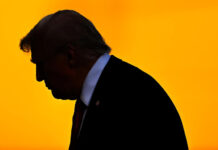JANUARY 2, 2018
 President Trump and Britain’s Queen Elizabeth II pass guards at Windsor Castle in England on July 13. (Matt Dunham/ Pool/AP)
President Trump and Britain’s Queen Elizabeth II pass guards at Windsor Castle in England on July 13. (Matt Dunham/ Pool/AP)
MELBOURNE, Australia — U.S. congressional leaders will head to the White House on Wednesday to find a way out of the partial U.S. government shutdown that has engulfed the country since Dec. 22. Any solution is likely to force both sides into concessions, even though President Trump has so far shown no willingness to withdraw his demands for billions of dollars for a U.S.-Mexico border wall.
As an Internet meme points out, it could all have been so much easier for Americans had the United States never broken away from the Brits. Just ask the Australians.
The nation of 25 million has experienced a government shutdown only once, in 1975, and it left Australia’s political system in turmoil for years. When the country’s political leaders couldn’t agree on a new budget and shut down the government, Queen Elizabeth II’s Australian representative simply stepped in and dismissed Australia’s prime minister and then dissolved Parliament when its members complained.
Politics Down Under may often be ridiculed as a below-average performer in terms of stability, but the episode left its mark. Australia has had 10 new prime ministers since then, but not a single new government shutdown.
The 1975 shutdown, said Monash University emeritus professor Jenny Hocking, still serves as a warning against “using chaos to achieve political change.”
“It was deeply divisive and enormously polarizing. Opinion polls quickly showed that voters didn’t accept this,” she said.
Meanwhile, in the United States, there have been more than 20 budget impasses since. Every time, hundreds of thousands of federal workers have to halt their work in a tradition that has become a metaphor abroad for U.S. polarization and government dysfunction.
Republicans and Democrats are continuing to blame each other for the ongoing partial government shutdown, which is now in its second week.
At first glance, Australian budget votes would actually appear to be riskier than those in the United States, where opposition parties less frequently control one of the two chambers in Congress.
But whereas at least 60 percent of all U.S. senators need to approve new budgets, many other countries — including Australia — require only a majority. Defeat is technically still possible in Australia, but there is unofficial agreement not to risk such a stalemate again.
Even if, despite all this, Australian lawmakers voted against the budget, funding would not immediately stop, and payments to employees would only halt after a longer period of time.
In 1975, the measures in place to prevent shutdowns broke down when Australia’s ruling Labor Party was challenged by the main opposition Liberal Party in the Senate. On paper, the Liberal Party argued that the proposed spending programs were too expensive, especially as the country was heading into a possible recession. But the Liberal Party’s demands were not actually intended to be met — the party was instead eyeing a new election to topple Prime Minister Gough Whitlam.
“Whitlam at that point was operating in a deeply troubled and chaotic manner,” said Australian politics researcher John Doyle, who said that Whitlam bears some responsibility for the escalation. But things really went downhill when his opponent, Malcolm Fraser, began to “act with great political ruthlessness and complete disregard for conventions of the political system.”
When Whitlam failed to negotiate a compromise, the budget went unfunded after the Senate continued to defer the key vote. As part of their plan to gain power, the opposition Liberals then urged Whitlam to hold elections for half of the House of Representatives to solve the deadlock, not so secretly hoping that their party would take full control. Instead, Whitlam followed his own script and announced elections for half of the opposition-controlled Senate.
That’s when the queen’s Australian representative, Governor-General Sir John Kerr, came in and suddenly fired the prime minister and appointed opposition leader Malcolm Fraser in his place. The new Liberal prime minister immediately and successfully held a new vote in the Senate to pass the budget, but when the Labor-controlled House of Representatives learned of the rapid moves, it launched a no-confidence vote against the new prime minister. In the end, the queen’s representative dissolved Parliament in a quick succession of events but kept the Liberal Party’s leader in power on an interim basis.
“It was the opposite of a perfect storm,” said Doyle.
The extent of the queen’s involvement in those decisions is still not fully understood. While Buckingham Palace maintains that Queen Elizabeth II was unaware, recently revealed records have suggested the opposite. A lawsuit is pending to make public the communications between Buckingham Palace and Kerr. The secrecy indicates how controversial Kerr’s decisions were at the time, as he was serving in a role that is usually ceremonial. It also shows how explosive the details surrounding the incident remain, amid demands from some in Australia to fully break free from the British crown.
Australia never fully terminated its dependence on the British monarchy and remains a member of the Commonwealth of Nations. As Australia is an independently governed country, the queen’s powers have not been used except in 1975. The queen remains the head of state and theoretically retains certain powers over Australian politics — much like her powers in Britain, which she is never meant to exercise.
Despite the questionable legal basis for Fraser’s path to power, he governed until 1983. For him, the budget impasse was a short-lived success, which swept his party to power but tainted his premiership.
“His government was often indecisive in the following years, which has been explained by the controversies surrounding the way he came to power,” said Doyle.
Both he and Hocking agreed that another budget impasse is not entirely outside the realm of possibility. “But in practice, it isn’t something that is ever being considered,” said Hocking.
“The outcry would simply be too big.”
Courtesy/Source: Washington Post







































































































